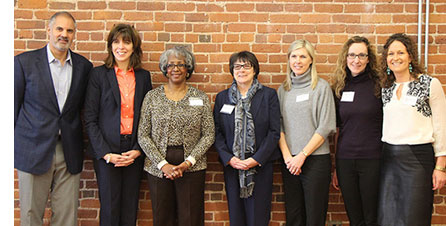Return to "Leading the Conversation" >
RECOMMENDATION & ACTION STEPS
Programs should be designed with sufficient intensity and depth to have an impact on children’s language and literacy development, and, once they have demonstrated impact, be brought to scale
There is clear evidence that programs designed to support children’s early environments and experiences—especially in the domains of reading and language—can have positive impacts that extend into adulthood, enhancing life for individuals and communities. Unfortunately, despite great promise and significant effort in design and execution, most interventions have been shown to produce negligible effects. Stakeholders are thus left discouraged: Funders and providers feel the sting of wasted time and money; families and communities lose sight of their children’s promise. Therefore, it is critical to develop a new approach to promoting language and reading in early childhood that ensures programs and children reach their potential. One might wonder—why a new approach and not necessarily new programs? Many of our current programs and supports don’t necessarily lack in good design—what they most often lack is heft and longevity, and/or high quality implementation to impact outcomes.
ACTION STEPS
- Self-study for impact.
- Key ingredient: What’s working?
- Sufficient dosage: Are we augmenting behaviors enough to make a difference?
- Implementation characteristics: Are we really delivering the program or support?
- Timing: Are we focused on prevention and early identification of reading difficulties?
SNAPSHOT
Catching Our Kids Early: Boosting Language for Later Reading Success
Simone was connected to early intervention—a statewide, family-centered, developmental service—by her daughter’s pediatrician. Now, a typical Wednesday morning for Simone and daughter Talita begins with a visit from Rebecca, an early-childhood specialist. On one particular visit, before their circle time routine, Simone pages through an old photo album, engaging Talita and Rebecca in a conversation about her family. Next, the three sing and act out Talita’s new favorite nursery rhymes, read a children’s book the family will borrow for the week, and make plans for future activities that would interest the family while also building Talita’s language. Before Rebecca leaves for her next home visit, she answers a few parenting questions that had been troubling Simone. Rebecca departs, leaving Simone a flier with the library’s summer programs. Like 94% of her peers who also entered the program lagging behind on expected developmental milestones, Talita’s rate of growth on measures of language development is likely to increase following participation in the program, which promotes increased language and reading activities between parents and child.

 EVENT EVENT
March 27, 2014
Designing and Implementing Effective Volunteer Programs Focused on Literacy
Event Program includes agenda and speaker bios.
|